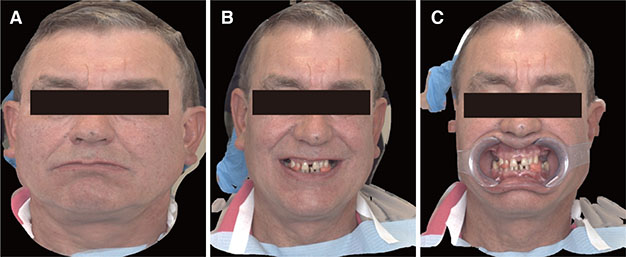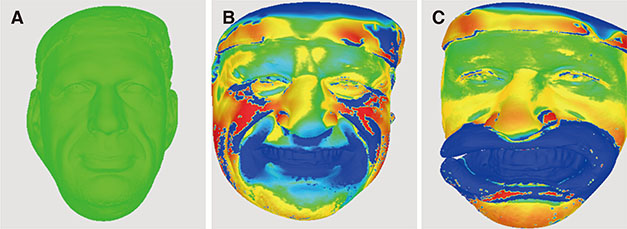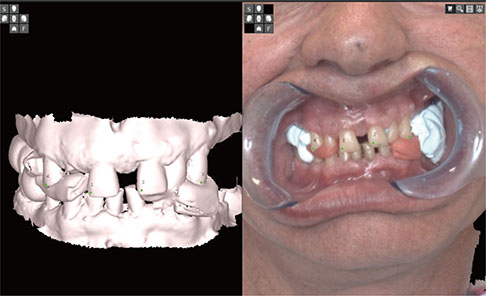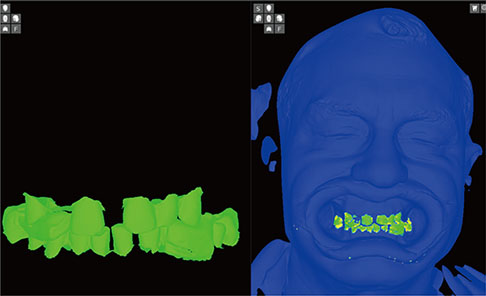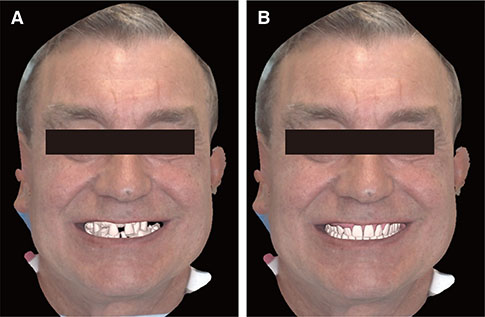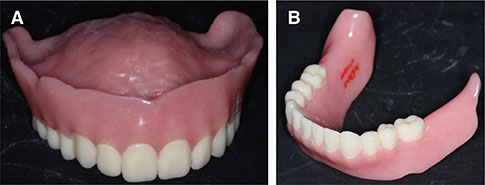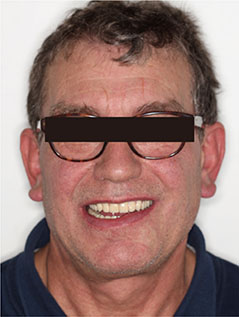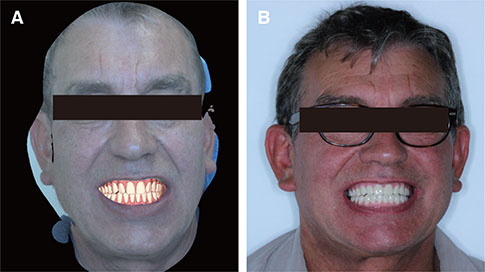J Adv Prosthodont.
2017 Oct;9(5):381-386. 10.4047/jap.2017.9.5.381.
Integrating 3D facial scanning in a digital workflow to CAD/CAM design and fabricate complete dentures for immediate total mouth rehabilitation
- Affiliations
-
- 1Department of Oral Implantology and Prosthetic Dentistry, Academic Centre for Dentistry Amsterdam (ACTA), Amsterdam, The Netherlands. b.hassan@acta.nl
- 2Department of Prosthodontics, Vienna School of Interdisciplinary Dentistry, Medical University Vienna, Wien, Austria.
- KMID: 2393224
- DOI: http://doi.org/10.4047/jap.2017.9.5.381
Abstract
- PURPOSE
To integrate extra-oral facial scanning information with CAD/CAM complete dentures to immediately rehabilitate terminal dentition.
MATERIALS AND METHODS
Ten patients with terminal dentition scheduled for total extraction and immediate denture placement were recruited for this study. The patients were submitted to a facial scanning procedure using the in-office PritiMirror scanner with bite registration records in-situ. Definitive stone cast models and bite records were subsequently submitted to a lab scanning procedure using the lab scanner (iSeries DWOS; Dental Wings). The scanned models were used to create a virtual teeth setup of a complete denture. Using the intra-oral bite records as a reference, the virtual setup was incorporated in the facial scan thereby facilitating a virtual clinical evaluation (teeth try-in) phase. After applying necessary adjustments, the virtual setup was submitted to a CAM procedure where a 5-axis industrial milling machine (M7 CNC; Darton AG General) was used to fabricate a full-milled PMMA immediate provisional prosthesis.
RESULTS
Total extractions were performed, the dentures were immediately inserted, and subjective clinical fit was evaluated. The immediate provisional prostheses were inserted and clinical fit, occlusion/articulation, and esthetics were subjectively assessed; the results were deemed satisfactory. All provisional prostheses remained three months in function with no notable technical complications.
CONCLUSION
Ten patients with terminal dentition were treated using a complete digital approach to fabricate complete dentures using CAD/CAM technology. The proposed technique has the potential to accelerate the rehabilitation procedure starting from immediate denture to final implant-supported prosthesis leading to more predictable functional and aesthetics outcomes.
MeSH Terms
Figure
Reference
-
1. Shor A, Shor K, Goto Y. Rehabilitation of failing dentition with immediate denture prostheses: technique for a predictable esthetic and functional outcome. Compend Contin Educ Dent. 2006; 27:168–176.2. Bouma LO, Mansueto MA, Koeppen RG. A nontraditional technique for obtaining optimal esthetics for an immediate denture: a clinical report. J Prosthodont. 2001; 10:97–101.3. Kattadiyil MT, Jekki R, Goodacre CJ, Baba NZ. Comparison of treatment outcomes in digital and conventional complete removable dental prosthesis fabrications in a predoctoral setting. J Prosthet Dent. 2015; 114:818–825.4. Lozada JL, Garbacea A, Goodacre CJ, Kattadiyil MT. Use of a digitally planned and fabricated mandibular complete denture for easy conversion to an immediately loaded provisional fixed complete denture. Part 1. Planning and surgical phase. Int J Prosthodont. 2014; 27:417–421.5. Kattadiyil MT, Goodacre CJ, Baba NZ. CAD/CAM complete dentures: a review of two commercial fabrication systems. J Calif Dent Assoc. 2013; 41:407–416.6. Bidra AS, Taylor TD, Agar JR. Computer-aided technology for fabricating complete dentures: systematic review of historical background, current status, and future perspectives. J Prosthet Dent. 2013; 109:361–366.7. Hassan B, Giménez Gonzáles B, Tahmaseb A, Jacobs R, Bornstein MM. Three-dimensional facial scanning technology: applications and future trends. Forum Implantologicum. 2014; 10:77–86.8. Da Silveira AC, Daw JL Jr, Kusnoto B, Evans C, Cohen M. Craniofacial applications of three-dimensional laser surface scanning. J Craniofac Surg. 2003; 14:449–456.9. Mankovich NJ, Samson D, Pratt W, Lew D, Beumer J 3rd. Surgical planning using three-dimensional imaging and computer modeling. Otolaryngol Clin North Am. 1994; 27:875–889.10. Cattoni F, Mastrangelo F, Gherlone EF, Gastaldi G. A new total digital smile planning technique (3D-DSP) to fabricate CAD-CAM mockups for esthetic crowns and veneers. Int J Dent. 2016; 2016:6282587.11. Spyropoulou PE, Razzoog ME, Duff RE, Chronaios D, Saglik B, Tarrazzi DE. Maxillary implant-supported bar overdenture and mandibular implant-retained fixed denture using CAD/CAM technology and 3-D design software: a clinical report. J Prosthet Dent. 2011; 105:356–362.12. Rangel FA, Maal TJ, Bergé SJ, van Vlijmen OJ, Plooij JM, Schutyser F, Kuijpers-Jagtman AM. Integration of digital dental casts in 3-dimensional facial photographs. Am J Orthod Dentofacial Orthop. 2008; 134:820–826.13. Rosati R, De Menezes M, Rossetti A, Sforza C, Ferrario VF. Digital dental cast placement in 3-dimensional, full-face reconstruction: a technical evaluation. Am J Orthod Dentofacial Orthop. 2010; 138:84–88.14. Joda T, Gallucci GO. The virtual patient in dental medicine. Clin Oral Implants Res. 2015; 26:725–726.15. Hassan B, Gimenez Gonzalez B, Tahmaseb A, Greven M, Wismeijer D. A digital approach integrating facial scanning in a CAD/CAM workflow for full mouth implants supported rehabilitation of the edentulous patient: A pilot clinical study. J Prosthet Dent. 2016; [in press].
- Full Text Links
- Actions
-
Cited
- CITED
-
- Close
- Share
- Similar articles
-
- Fabrication of complete denture using conventional method and monolithic digital denture system: a case report
- The treatment of an edentulous patient with conventional complete denture and CAD/CAM complete denture
- Fabrication of computer-aided design/computer-aided manufacturing complete denture and conventional complete denture: case report
- Fabrication of CAD-CAM complete denture using existing provisional denture and digital facebow transfer
- Full mouth rehabilitation of a severely worn dentition using intraoral scanner and the CAD/CAM double scanning technique


